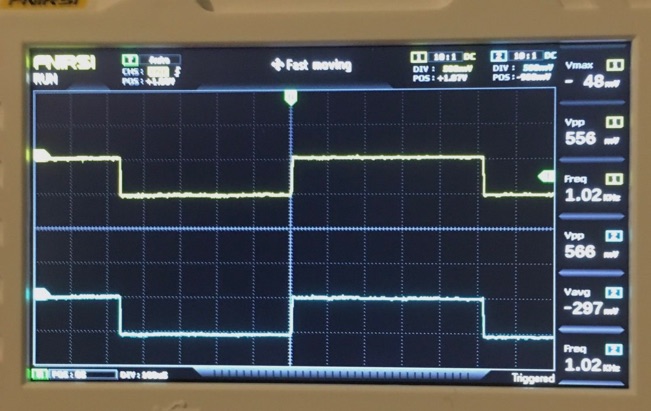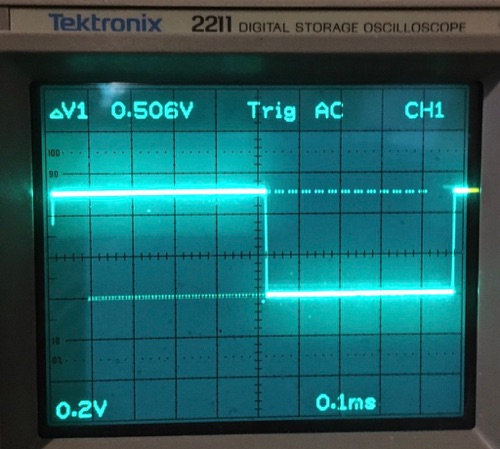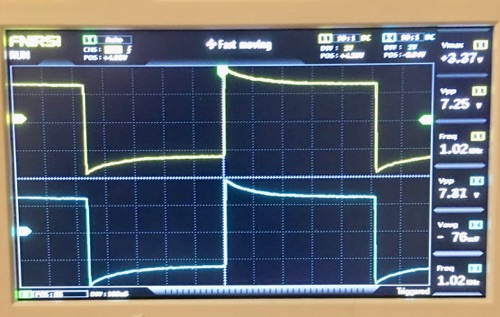Using the FNIRSI 1014D Oscilloscope


Using the 1014D Scope
Saturday, November 19, 2022

The FNIRSI 1014D oscilloscope works differently from my older oscilloscopes in several ways. For starters, it is much less sensitive than my Tektronix 2211 or B&K 1472. For any measurement where loading of the circuit being measured is important, that is any circuit whose impedance is much over 1000 ohms, or frequency is much over 100KHz, you need to use X10 probes to have a small enough loading effect not to disturb the circuit. That means using X10 probes most of the time. With the FNIRSO’s 50mV/div maximum sensitivity and 10X probe, a 500mV signal only produces 1 division on screen, and is noisy at that sensitivity.
Here is a snapshot of the screen using the probes that come with the scope, displaying a calibrated 500mV 1KHz square wave. Screen pictures taken with my phone.

For comparison, the same signal as displayed by the Tektronix scope.
The Tek doesn’t measure the voltage directly, it displays the voltage between the two horizontal cursors which are set manually by the user. This is more work, but allows the user to set which part of a signal he is measuring. He can measure between any two points on the screen, vertically for voltage and horizontally for time.


In order to use the FNIRSI scope for common audio measurements, I built a preamp for it in the previous episode. The preamp adds gain of 10X or 100X and has much lower inout capacitance so it loads the circuit under test much less. Used with X10 probes, it can signal trace most audio amplifiers without changing their operation.
Here the preamp is used with the probes that come with the FNIRSI scope set to X10. The probe calibration capacitors cannot be set low enough for an accurate square wave display.
Noise on the traces is reduced because my preamps are much quieter than the scope’s internal amplifiers.
Using probes from Tektronix, B&K, or Test Probes Inc. with the preamp allows proper square wave calibration. A similar low capacitance, higher sensitivity vertical amplifier would make the scope much more useful for audio measurements. Notice the displayed voltage is also more accurate.
The last three images are screen captures using the “S PIC” button on the scope.
It seems that this scope measures voltage change at the rising edge of a signal, since an underdamped square wave is measured as larger than life, and an overdamped wave is measured as smaller than its actual peak-to peak value.
Another quirk of the scope firmware came to light when I used the “S PIC” button on the scope. The screen was captured all right, but connecting the supplied USB cable to my laptop and copying the bitmap files crashed the scope. It had to be turned off and back on to recover.
The scope does what I need, but could definitely be more useful with some inexpensive upgrades. How other low cost scopes compare, I don’t know. Most reviews I’ve seen compare cheap scopes to much more expensive ones, and the criticism centers around the claimed frequency response. For audio and analog video use, a 30MHz scope is fast enough, so I don’t care that the 100MHz 1GS/S spec is stretching the truth. Some of the oddities could be addressed in future firmware upgrades, so I’ll be watching for those. Firmware is currently at version 3.0. The model 1013D tablet scope is smaller with the same screen size and has internal battery power. If you don’t need a signal generator, it could be the better choice. It has the same basic internals and limitations as the 1014D. There are a few reports of trouble with the touch screen on that one. It remains to be seen how well these hold up since they are relatively new to the market.
Despite its quirks, I am glad I bought it. It’s less handy than it could be, since it’s three boxes at present; the scope, a power bank, and the preamp. There is lots of room inside the scope case for extra circuitry, so these could be built inside. The battery is velcro’ed to the back of the scope. The preamp is useful with other gadgets so I haven’t built it into the scope case. I may do so in the future.
For a deep dive into FNIRSI scopes, check out this thread on EEVBlog.com:
https://www.eevblog.com/forum/testgear/fnirsi-1013d-100mhz-tablet-oscilloscope/











